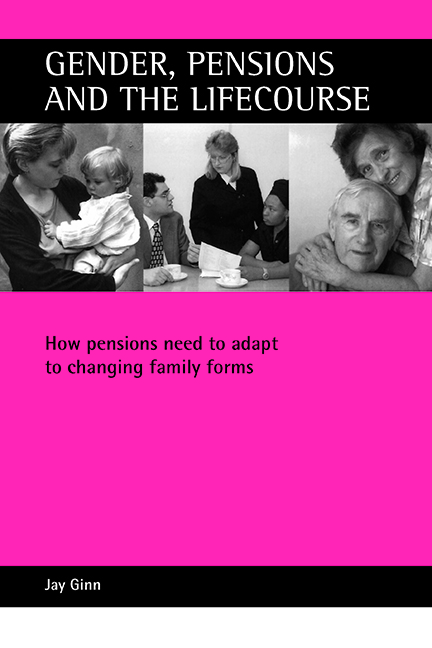Book contents
- Frontmatter
- Contents
- List of tables and figures
- Acknowledgements
- one Trends in gender relations, employment and pensions
- two Choice and risk in pensions: gender and class inequalities
- three Pension prospects for minority ethnic groups
- four Changing patterns of partnership: divorce and pensions
- five Impact of motherhood on pension acquisition: differentiation according to education
- six Gender and pensions in the European Union: towards an independence model?
- seven British pension policy: a gender perspective on alternative rescue plans
- References
- Appendix Statistical tables
- Index
two - Choice and risk in pensions: gender and class inequalities
Published online by Cambridge University Press: 20 January 2022
- Frontmatter
- Contents
- List of tables and figures
- Acknowledgements
- one Trends in gender relations, employment and pensions
- two Choice and risk in pensions: gender and class inequalities
- three Pension prospects for minority ethnic groups
- four Changing patterns of partnership: divorce and pensions
- five Impact of motherhood on pension acquisition: differentiation according to education
- six Gender and pensions in the European Union: towards an independence model?
- seven British pension policy: a gender perspective on alternative rescue plans
- References
- Appendix Statistical tables
- Index
Summary
Pension providers and governments alike warn that individuals need to save more through private pensions. Most economists attribute lack of saving to irrational behaviour described as ‘myopia’ – an inappropriately short time horizon. Yet individuals often have sound reasons for reluctance to save additional amounts towards pensions (Rowlingson, 2002). These include a rational response to uncertainties, especially the risk of a poor return on investments. The mis-selling of personal pensions and the theft and misuse of occupational funds are indications of the way pension risks and costs are increasingly passed on to individuals (Ward, 1996; Peggs, 2000; Ring, 2002). Meanwhile state pensions are shrinking as governments seek to reduce state spending on pensions, as part of a more general rolling back of the welfare state (Aldridge, 1998). Confronted with unsatisfactory state pensions and risky private provision, even individuals who can afford to are understandably reluctant to save for their old age in this way.
Widening choice, growing complexity and uncertainty about the future of pensions means an increasing risk of making decisions that do not provide the best value for money. When politicians and pensions experts admit they find the British pension system hard to grasp, it is no wonder that individuals are bemused by pension scheme rules, and that many feel alienated or misled by ‘information’ from the state or the purveyors of private pensions. For those with interrupted and unpredictable employment trajectories, choosing an optimal pension strategy becomes well-nigh impossible.
This chapter first considers the issue of pension choice in the context of uncertainty about risks in the various types of second tier pensions. Gender and class inequalities in pension coverage are then analysed using data from the General Household Survey (GHS). The characteristics of employees who opted for a personal pension or who remained in the state pension scheme are examined, distinguishing between those who could have belonged to an occupational pension and those who lacked access to such a scheme. The chapter finally considers the issue of mis-selling of personal pension plans to men and women for whom this was unlikely to be the best option.
Choice, information and risk
Pension choices were limited during the post-war period before the 1980s. Where employers offered an occupational pension scheme, membership was compulsory.
- Type
- Chapter
- Information
- Gender, Pensions and the LifecourseHow Pensions Need to Adapt to Changing Family Forms, pp. 21 - 36Publisher: Bristol University PressPrint publication year: 2003



